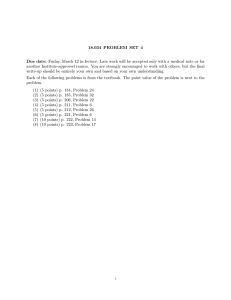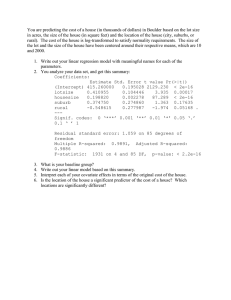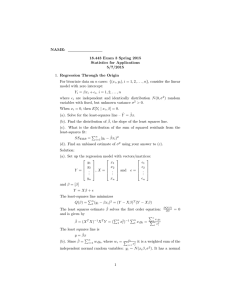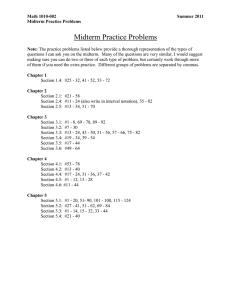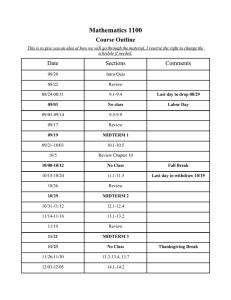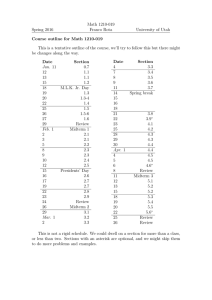NAME: 18.443 Exam 3 Spring 2015 5/7/2015
advertisement
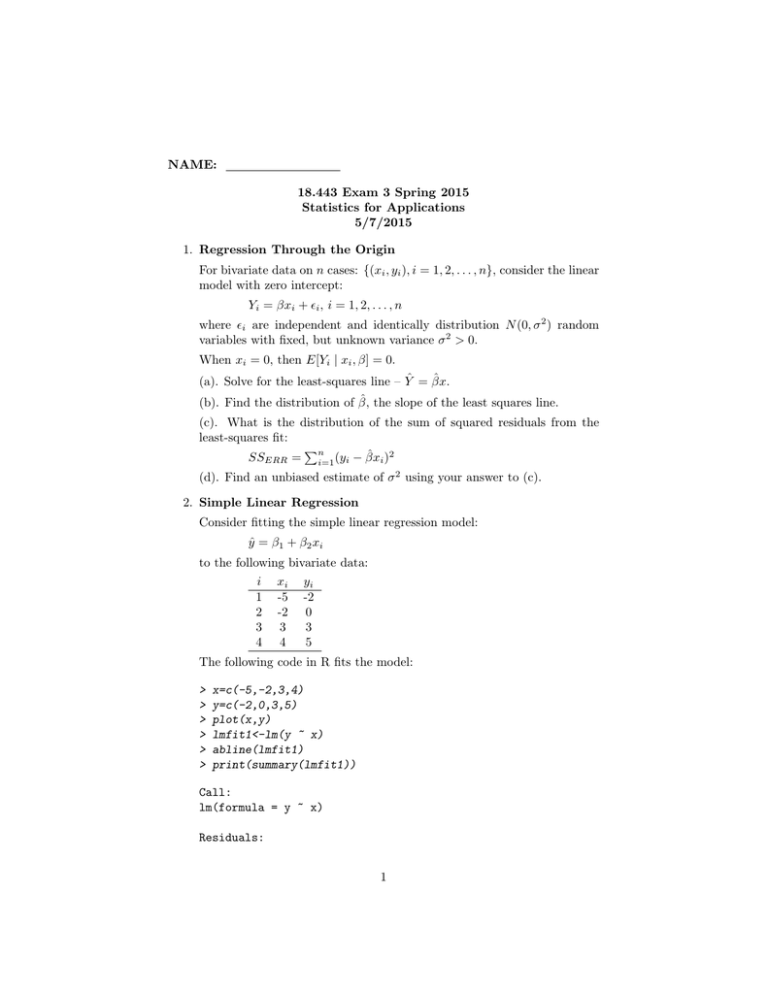
NAME:
18.443 Exam 3 Spring 2015
Statistics for Applications
5/7/2015
1. Regression Through the Origin
For bivariate data on n cases: {(xi , yi ), i = 1, 2, . . . , n}, consider the linear
model with zero intercept:
Yi = βxi + Ei , i = 1, 2, . . . , n
where Ei are independent and identically distribution N (0, σ 2 ) random
variables with fixed, but unknown variance σ 2 > 0.
When xi = 0, then E[Yi | xi , β] = 0.
ˆ
(a). Solve for the least-squares line – Yˆ = βx.
ˆ
the slope of the least squares line.
(b). Find the distribution of β,
(c). What is the distribution of the sum of squared residuals from the
least-squares fit:
n
ˆ i )2
SSERR =
(yi − βx
i=1
(d). Find an unbiased estimate of σ 2 using your answer to (c).
2. Simple Linear Regression
Consider fitting the simple linear regression model:
ŷ = β1 + β2 xi
to the following bivariate data:
i
1
2
3
4
xi
-5
-2
3
4
yi
-2
0
3
5
The following code in R fits the model:
>
>
>
>
>
>
x=c(-5,-2,3,4)
y=c(-2,0,3,5)
plot(x,y)
lmfit1<-lm(y ~ x)
abline(lmfit1)
print(summary(lmfit1))
Call:
lm(formula = y ~ x)
Residuals:
1
1
2
3
0.11111 -0.05556 -0.66667
4
0.61111
Coefficients:
Estimate Std. Error t value Pr(>|t|)
(Intercept) 1.50000
0.32275
4.648
0.0433 *
x
0.72222
0.08784
8.222
0.0145 *
--Signif. codes: 0 '***' 0.001 '**' 0.01 '*' 0.05 '.' 0.1 ' ' 1
0.9569
−2
−1
0
1
y
2
3
4
5
Residual standard error: 0.6455 on 2 degrees of freedom
Multiple R-squared: 0.9713,
Adjusted R-squared:
F-statistic: 67.6 on 1 and 2 DF, p-value: 0.01447
−4
−2
0
2
4
x
(a). Solve directly for the least-squares estimates of the intercept and
slope of the simple linear regression (obtain the same values as in the R
print summary)
(b). Give formulas for the least-squares estimates of β1 and β2 in terms
of the simple statistics
x = 0, and y = 1.5
sx =
Sx2 =4.2426
2
sy =
�
Sy2 =3.1091
r = Corr(x, y) =
Sxy
Sx Sy
=0.9855
(c). In the R print summary, the standard error of the slope β̂2 is given
as σ̂βˆ2 =0.0878
Using σ̂ =0.65, give a formula for this standard error, using the statistics
in (b).
(d). What is the least-squares prediction of Ŷ when X = x = 0, and what
is its standard error (estimate of its standard deviation)?
3. Suppose that grades on a midterm and final have a correlation coefficient of
0.6 and both exams have an average score of 75. and a standard deviation
of 10.
(a). If a student’s score on the midterm is 90 what would you predict her
score on the final to be?
(b). If a student’s score on the final was 75, what would you guess that
his score was on the midterm?
(c). Consider all students scoring at the 75th percentile or higher on the
midterm. What proportion of these students would you expect to be at
or above the 75th percentile of the final? (i) 75%, (ii) 50%, (iii) less than
50%, or (iv) more than 50%.
Justify your answers.
4. CAPM Model
The CAPM model was fit to model the excess returns of Exxon-Mobil (Y)
as a linear function of the excess returns of the market (X) as represented
by the S&P 500 Index.
Yi = α + βXi + Ei
where the Ei are assumed to be uncorrelated, with zero mean and constant
variance σ 2 . Using a recent 500-day analysis period the following output
was generated in R:
3
0.01
0.00
−0.02
−0.04
Y (Stock Excess Return)
0.02
0.03
XOM
−0.02
−0.01
0.00
0.01
0.02
X (Market Excess Return)
> print(summary(lmfit0))
Call:
lm(formula = r.daily.symbol0.0[index.window] ~ r.daily.SP500.0[index.window],
x = TRUE, y = TRUE)
Residuals:
Min
1Q
-0.038885 -0.004415
Median
0.000187
3Q
0.004445
Max
0.026748
Coefficients:
Estimate Std. Error t value Pr(>|t|)
(Intercept)
-0.0004805 0.0003360
-1.43
0.153
r.daily.SP500.0[index.window] 0.9190652 0.0454380
20.23
<2e-16
Residual standard error: 0.007489 on 498 degrees of freedom
Multiple R-squared: 0.451,
Adjusted R-squared: 0.4499
F-statistic: 409.1 on 1 and 498 DF, p-value: < 2.2e-16
(a). Explain the meaning of the residual standard error.
(b). What does “498 degrees of freedom” mean?
4
(c). What is the correlation between Y (Stock Excess Return) and X
(Market Excess Return)?
(d). Using this output, can you test whether the alpha of Exxon Mobil is
zero (consistent with asset pricing in an efficient market).
H0 : α = 0 at the significance level α = .05?
If so, conduct the test, explain any assumptions which are necessary, and
state the result of the test?
(e). Using this output, can you test whether the β of Exxon Mobil is less
than 1, i.e., is Exxon Mobil less risky than the market:
H0 : β = 1 versus HA : β < 1.
If so, what is your test statistic; what is the approximate P -value of the
test (clearly state any assumptions you make)? Would you reject H0 in
favor of HA ?
5. For the following batch of numbers:
5, 8, 9, 9, 11, 13, 15, 19, 19, 20, 29
(a). Make a stem-and-leaf plot of the batch.
(b). Plot the ECDF (empirical cumulative distribution function) of the
batch.
(c). Draw the Boxplot of the batch.
6. Suppose X1 , . . . , Xn are n values sampled at random from a fixed distri­
bution:
Xi = θ + Ei
where θ is a location parameter and the Ei are i.i.d. random variables with
mean zero and median zero.
(a). Give explicit definitions of 3 different estimators of the location pa­
rameter θ.
(b). For each estimator in (a), explain under what conditions it would be
expected to be better than the other two.
5
MIT OpenCourseWare
http://ocw.mit.edu
18.443 Statistics for Applications
Spring 2015
For information about citing these materials or our Terms of Use, visit: http://ocw.mit.edu/terms.
